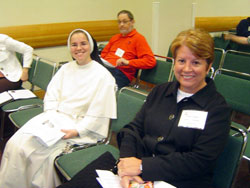Student engagement is main message at education conference

Dominican Sister Maria Fidelis Gray, left, the principal of Our Lady of Mt. Carmel School in Carmel, Ind., and Anne Dumas, the principal of St. Augustine School in Renssselaer, Ind., both in the Lafayette Diocese, gear up for a breakout session for administrators on Oct. 29. (Photo by Mary Banta)
By Brigid Curtis Ayer (Special to The Criterion)
“If you cannot connect with kids, you cannot teach.”
Keynote speakers Eric Jensen and Debbie Silver drove home this message to nearly 2,500 non-public school educators who traveled to Indianapolis to learn how to engage students during the Indiana Non-Public Education Conference at the Indiana Convention Center on Oct. 28-29. The conference was hosted by the Indiana Non-Public Education Association (INPEA). (Related: What is the Indiana Non-Public Education Association?)
The Oct. 28 keynote address was delivered by Jensen, the founder of a brain-based learning center known as the Jensen Learning Corporation. He offered strategies for student engagement based on several discoveries about the brain.
Jensen defines brain-based teaching as implementing educational strategies based on current cognitive science.
“Some education strategies have absolutely no research basis at all or are based on either out of date or highly biased research—which renders them ineffective,” Jensen said. “Every time a teacher struggles with poor achievement, there is a mismatch between what the teacher is doing in the classroom and what really works.”
Children do not arrive at school pre-assembled by their DNA as was previously believed, Jensen said.
“Instead, they are glued together by life experiences. The single discovery of neuroplasticity means that the brain changes by input from the environment,” Jensen said. “Teaching is a highly targeted form of environmental input. Therefore, teaching and teaching methods change the brain.”
Jensen, who lives in Hawaii, has taught at every level and authored 24 books. He told teachers that what they do in the classroom really matters.
“Current research shows [that] everything a teacher does in the classroom will affect and change the student’s brain development,” he said. “You have much more to do with how your students turn out than you think.”
Silver, the keynote speaker on Oct. 29, delivered her message of student engagement in a candid, yet funny manner based on her 40 years of teaching.
Drumming to the Beat of Different Marchers, the title of Silver’s book and her keynote address, gave the teachers practical strategies for reaching students who may seem to be unreachable.
Silver, who holds a doctorate in education and lives in Melissa, Texas, said, “First, you need to find out where each student really is. Not where the standards say they should be, or where you think they should be, but where they really are. Then raise the bar just beyond where the students are. Make them stretch, but also make the goal reachable.
“All students must be given a reasonable chance to learn and succeed,” she explained. “When they are given this opportunity, they will be engaged and reach beyond where even they thought possible. Raising the bar and steering kids toward self-efficacy is what teachers need to be doing in the classroom.”
The author said that she understood the pressures of content, paperwork and other teacher responsibilities, but told the conference attendees, “When you’re in the classroom, being really present to the students is the best thing [you] can do for their educational success.”
Steve Westrick, the principal of St. Mary School in Muncie, Ind., in the Lafayette Diocese, said he enjoyed the feeling of community at the conference.
“We don’t see each other day to day, but when we gather as a group … , it is very powerful. We realize we are not alone,” he said. “We are part of a large community of educators who are working to make a difference in the lives of young people every day.”
Pam Daugherty, who teachers the third grade at St. Mary School in New Albany, said that she was most interested in learning about differentiated learning.
“Every child should have an I.E.P.—an individual education plan—because all students are different and learn differently,” she said. “It’s tough to do, but if your heart is in it, you will find a way.”
John Elcesser, INPEA executive director, thanked the teachers for their hard work. He said because of it, his job is “made easy.”
In addition to the professional development opportunities and community building that the conference provides, Elcesser said the INPEA would be working the advocacy side during the upcoming 2010 Indiana General Assembly.
He also encouraged the educators to stay informed and engaged.
“As lawmakers return to the statehouse to consider a new budget and develop education policy, our educators and our school communities need to be a part of the public policy discussion,” Elcesser said. †
(Brigid Curtis Ayer is a correspondent for The Criterion.) †
